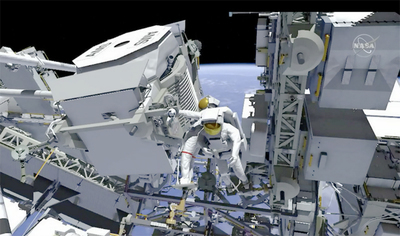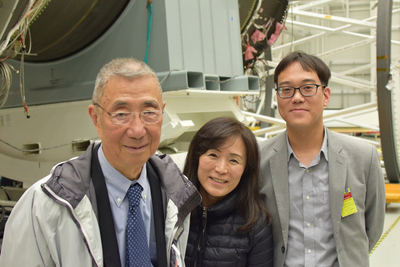NCKU and AIDC Participate the Most Difficult Space Maintenance Task Together


National Cheng Kung University (NCKU) and Aerospace Industrial Development Corporation (AIDC) are currently taking part in the international high-energy physics experiment, Alpha Magnetic Spectrometer (AMS-02), to install the Upgraded Thermal Tracker Pump System (UTTPS). The launch was made at Wallops, Virginia on November 2, 2019. President of NCKU, Prof. Huey-Jen Su and President of AIDC, Dr. Wan-Chun Ma were invited to watch the launch. On November 15, the NASA-ESA astronauts, Luca Parmitano and Andrew Morgan, have begun the manual installation in zero gravity, which is expected to take four extravehicular activities (EVA), or spacewalks, to complete. Follow by the EVAs on November 22 and December 2, the astronauts had installed UTTPS on AMS-02 successfully, and the last EVA will be taken place someday in January to make sure everything is okay. NASA considers it to be "the most difficult space maintenance task ever”.
“All of the hard work during the past two or three years is finally paying off. Out of all the international teams in this upgrade project, the NCKU-AIDC team was the only to deliver on time with quality exceeding NASA’s expectations.” Associate Prof. Yi Yang of the Department of Physics at NCKU, the project leader for UTTPS radiator, said with emotion.
The AMS-02 experiment is led by Nobel Prize laureate Prof. Samuel C.C. Ting. This high-energy particle detector has been operating on the International Space Station (ISS) for more than 8 years, and its cooling system needed an upgrade. The radiator of the UTTPS designed and manufactured by NCKU and AIDC has received high praise and recognition from NASA.
Yi Yang stated that during the production process, he perceived that “NASA was not always right as we assumed”. NASA had insisted that the specifications and parameters they had provided be followed for the welding of the tubes and manifold. However, senior engineers at AIDC immediately saw something wrong with the specifications and parameters and designed a new version. They sent the simulation data and received approval from NASA, thereby solving the troublesome manifold welding issue. The outer and inner diameters of the cooling pipes are 3.15 mm and 1.15 mm. NCKU and AIDC overcame several issues and developed an automatic cleaning system that was praised by NASA and added to the standard cleaning procedures of other pipes.
The installation of the UTTPS in AMS-02 will be completed manually by two astronauts over the course of four EVAs. ISS program manager Kirk Shireman once publicly stated that it was unprecedented for astronauts to manually replace instruments in space and that it would be more difficult than the repairs to the Hubble Space Telescope in 1994.
The origin of life and how the universe was created are mysteries that scientists have long been eager to solve. According to the Big Bang Theory, matter and antimatter should be created in equal amounts in the universe, but today, all that we have observed (from earth to space) has been matter, and we have yet to observe complex antimatter. The AMS-02 experiment aims to explore the universe, including the matter-antimatter asymmetry, in hopes of unraveling more unexplained mysteries.
“All of the hard work during the past two or three years is finally paying off. Out of all the international teams in this upgrade project, the NCKU-AIDC team was the only to deliver on time with quality exceeding NASA’s expectations.” Associate Prof. Yi Yang of the Department of Physics at NCKU, the project leader for UTTPS radiator, said with emotion.
The AMS-02 experiment is led by Nobel Prize laureate Prof. Samuel C.C. Ting. This high-energy particle detector has been operating on the International Space Station (ISS) for more than 8 years, and its cooling system needed an upgrade. The radiator of the UTTPS designed and manufactured by NCKU and AIDC has received high praise and recognition from NASA.
Yi Yang stated that during the production process, he perceived that “NASA was not always right as we assumed”. NASA had insisted that the specifications and parameters they had provided be followed for the welding of the tubes and manifold. However, senior engineers at AIDC immediately saw something wrong with the specifications and parameters and designed a new version. They sent the simulation data and received approval from NASA, thereby solving the troublesome manifold welding issue. The outer and inner diameters of the cooling pipes are 3.15 mm and 1.15 mm. NCKU and AIDC overcame several issues and developed an automatic cleaning system that was praised by NASA and added to the standard cleaning procedures of other pipes.
The installation of the UTTPS in AMS-02 will be completed manually by two astronauts over the course of four EVAs. ISS program manager Kirk Shireman once publicly stated that it was unprecedented for astronauts to manually replace instruments in space and that it would be more difficult than the repairs to the Hubble Space Telescope in 1994.
The origin of life and how the universe was created are mysteries that scientists have long been eager to solve. According to the Big Bang Theory, matter and antimatter should be created in equal amounts in the universe, but today, all that we have observed (from earth to space) has been matter, and we have yet to observe complex antimatter. The AMS-02 experiment aims to explore the universe, including the matter-antimatter asymmetry, in hopes of unraveling more unexplained mysteries.
Provider:
News Center
Date:
2019-12-20